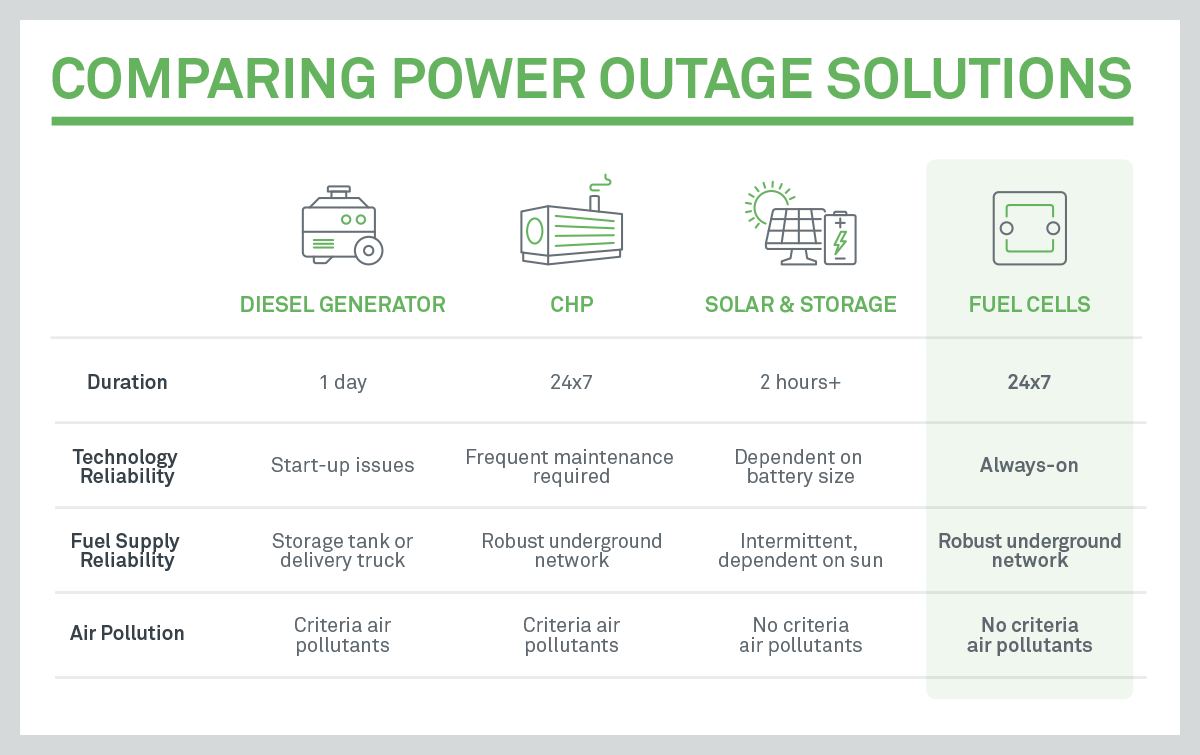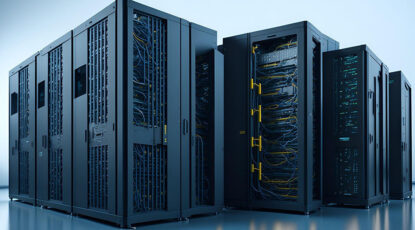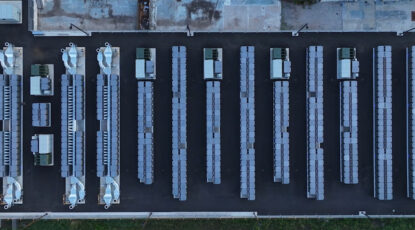In a few short weeks, the U.S. saw unprecedented stretches of its territory go dark. Millions of people across the nation experienced blackouts in October, feeling the first-hand wrath of a changing climate and an aging grid.
On the west coast, the threat of wildfires spurred three of California’s largest utilities to cut power to millions of people; some were without power for more than three days. Less than one week later, a record-breaking bomb cyclone hit the northeast and knocked out power to more than 600,000 homes and businesses.
Today, 24×7 electric power is a basic necessity – powering everything from our homes, to our businesses, to our transportation systems. Thus, these power outages are costly – in more ways than one.
Outages force schools, universities, and businesses to close for days. Food at homes, restaurants, and supermarkets spoils and goes to waste. Critical traffic lights and tunnel lights are powered down. Most worryingly, critical medical devices like oxygen and CPAP machines are disrupted. And those are just a few of the consequences.
In terms of economic cost, Michael Wara of the Stanford Woods Institute for the Environment estimated that the PG&E power shutdown alone could reach $2.5 billion. On an annual basis, the Department of Energy approximated power outages cost the U.S. economy a whopping $150 billion.
With so much on the line for businesses and communities alike, the prevailing question remains: how can we avoid power outages? How can we keep the lights on, regardless of weather conditions or infrastructure failures?
Before we dive into solutions, it’s important to understand the challenges our traditional grid model faces and the reasons it’s no longer cutting it.
What we’ll cover
- Why the Traditional Power Grid Isn’t Working
- Technologies that Protect Against Power Outages: What Are the Options?
- Using Fuel Cells as Building Blocks for Microgrids
Why the traditional power grid isn’t working
The nation’s power grid is aging and vulnerable, and there have been more than a decade of high-impact infrastructure failures and weather-related power disruptions to prove it.
The problem is the U.S. power grid relies on centralized generation of power with 200,000 miles of transmission lines and 5.5 million miles of distribution lines to deliver electricity to its destinations – which, most of the time, exist far from the power source. This means there are immeasurable opportunities for single points of failure that can quickly cascade through the system. Take, for example, what happened during the ‘Northeast Blackout of 2003,’ when a failure to trim trees in Ohio set off a chain of events across the grid that ultimately cut power to 55 million people in eight U.S. states and Canada.
Worse still, most of the nation’s power lines were constructed in the 1950s and 1960s with a 50-year life expectancy. In its most recent Infrastructure Report Card, the American Society of Civil Engineers rated our energy and electric systems a pitiful D+.
As we approach 2020, our electric system is in need of an upgrade, one that’s nearly two decades overdue. But unfortunately, the infrastructure upgrade required to ensure resilient power, 24 hours a day, 365 days a year, is extremely costly.
A full replacement would cost nearly $5 trillion. Commonly proposed grid hardening efforts like moving power lines underground are also costly. Some estimates for installing underground distribution lines are around the $1.16 million per mile mark, with the cost rising to $4.6 million per mile for cities.
With extreme weather events on the rise – like the never-before-seen wildfires and record-breaking bomb cyclones – the nation’s antiquated infrastructure will increasingly struggle. And with more frequent and longer-lasting power outages on the horizon, businesses and communities are beginning to take power into their own hands.
The best way to prepare for power outages is to treat the grid as backup power, and have your own source of primary power onsite. By generating power onsite right where the electricity is consumed, alternative energy technologies avoid the vulnerabilities (and costs) of the conventional transmission and distribution system.
Let’s take a look at some of the onsite power options currently available, both primary and backup, and evaluate which might work best for you.
Technologies that protect against power outages: What are the options?
Diesel Generator
Pros:
- The “tried-and-true” source of backup power in the commercial and industrial (C&I) space
- Widely available and relatively low upfront cost
- Easy for people and businesses to find, buy, and install in the U.S.
- Quick start-up time (less than 10 seconds)
- Allows diesel generators to operate quickly in emergency situations
- Higher fuel efficiency than gasoline generators
Cons:
- Do not provide the cost reduction benefits many other technologies do
- Only run as backups so customers continue to pay utility for regular electric costs
- Can be expensive to operate
- For example, it could cost $10,000 per day in fuel just to keep a two-megawatt generator running
- Harmful to the health of nearby communities
- Typical diesel generator exhaust contains more than 40 toxic air contaminants, including a variety of carcinogenic compounds
- Very noisy during operations
- Difficult to keep engines in proper state of readiness for emergencies
- Stringent regulations (permitting and registration requirements) based on air quality concerns limit when/how long generators can run
- Idle assets that sit unused 99% of the time
- Rely on onsite diesel reserves or delivery trucks for fuel supply
- High risk of running out of fuel when resupply is not possible (i.e. during natural disasters)
Takeaway: Diesel generators are a quick fix solution for short outages for those who don’t have the resources to spend on a long-term solution. They don’t work well if you need always-on power, 24×7 and they actively undermine efforts to mitigate climate change and improve air quality.
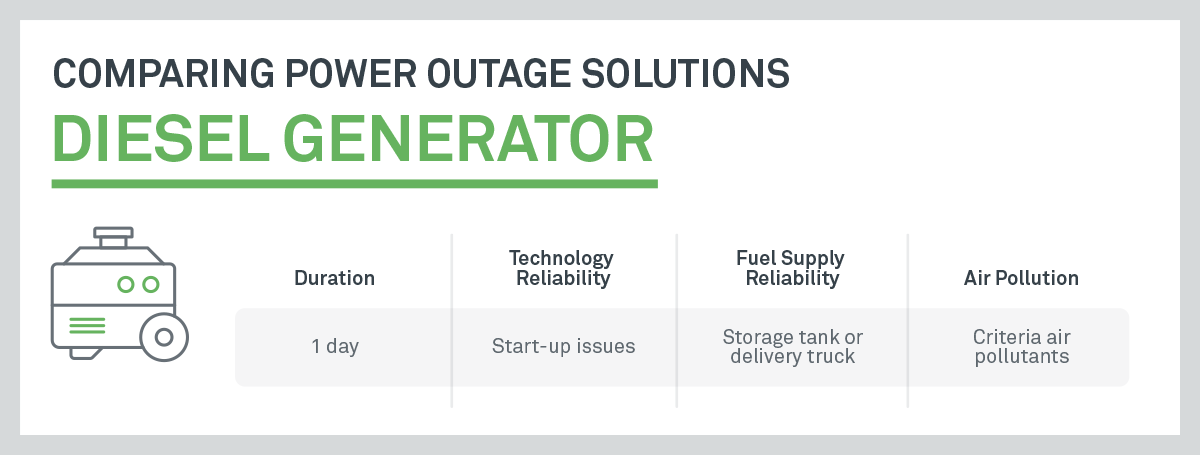
Combined Heat and Power (CHP) Systems
Pros:
- CHP (also known as cogeneration) recaptures residual heat created during electricity generation to use for heating, cooling, or generating steam
- Heat recovery results in efficiency gains, making CHP systems a more economical long-term investment for buildings with thermal loads
- Generate heat and power during regular operations (not just for backup)
- Eliminates risks associated with start-up failures for idle assets
- Helps reduce electric utility costs during normal operations
- Systems use less fuel due to higher efficiency
- Results in lower carbon dioxide emissions than conventional combustion-only sources
- Better fuel reliability than diesel generators
- Utilizes robust, redundant nature of the natural gas pipeline system
Cons:
- Systems rely on combustion to produce power
- Generate nitrogen oxides, sulfur oxides, and particulate emissions that contribute to smog and respiratory health issues
- Negative air quality impacts subject systems to air permitting requirements
- Engines require full system shutdowns during maintenance and are subject to forced power outages
- Results in some reliance on interruptible grid power
- Systems only capable of high efficiencies when most or all of the waste heat is actually used
- If buildings have little use for heat, or their needs for heat vary significantly, the efficiency and cost-effectiveness declines
- Extra engineering, equipment, and time required to install heat recovery may be costly and inefficient
Takeaway: CHP systems are the power solution for you if your facility consistently uses heat during operations, already has robust infrastructure to capture and distribute heat, and if you can tolerate some downtime. They don’t work well if you don’t have a consistent thermal load, if you need uninterruptible power, if you have limited space for installation, or if you are concerned with air quality impacts.
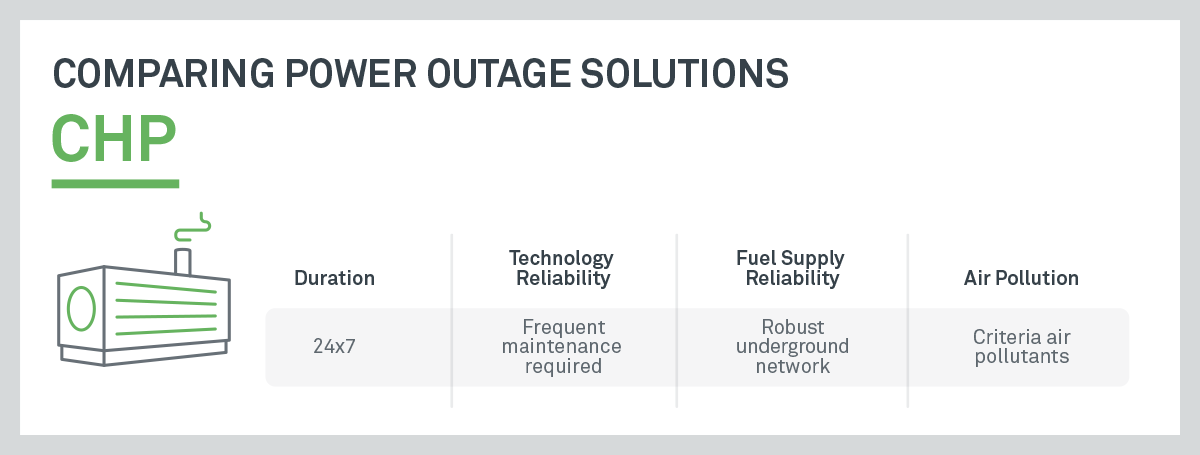
Solar + Storage
Pros:
- Solar is a renewable energy source that’s among the cleanest and most sustainable of power choices
- Zero harmful emissions
- When paired with energy storage (usually lithium-ion batteries) solar systems can provide an extended amount of power outside daylight hours
- Cost of solar has declined substantially over the past few decades
- Solar panels are relatively affordable and extremely accessible
- Systems become more affordable with incentives (via states, communities, and utilities) due to renewable benefits
- Solar and storage systems are used year-round (not just for backup)
- Helps reduce electric utility costs during normal operations
Cons:
- Fuel supply (sunlight) is intermittent, depending on location, time of day, season of the year, and weather conditions
- Batteries can help by storing up extra energy during periods of high sunlight, but current batteries typically only provide a few extra hours of storage capacity
- Lithium-ion batteries can also require a lot of space to provide storage capacity capable of lasting more than a few hours
- Large surface area is necessary to absorb or collect a useful amount of energy
- Amount of sunlight reaching a square foot of earth’s surface is relatively small
- Solar solutions are quite space-constrained, which is problematic for facilities located in or near highly populated, urban areas
- Low power density of solar systems limits viability for facilities that have high load requirements (meaning they use a significant amount of power daily)
Takeaway: Solar integrated with battery storage is a great solution for short-duration outages, when a facility has either relatively low power needs, or plenty of space for solar panels (e.g. carports, fields, or big roofs nearby), and when sustainability is on par with or more important than resiliency. Solar plus storage is not the best solution if a facility requires 24×7 availability of power, and cannot tolerate uncertainty around sunshine, storage capacity, and outage durations.
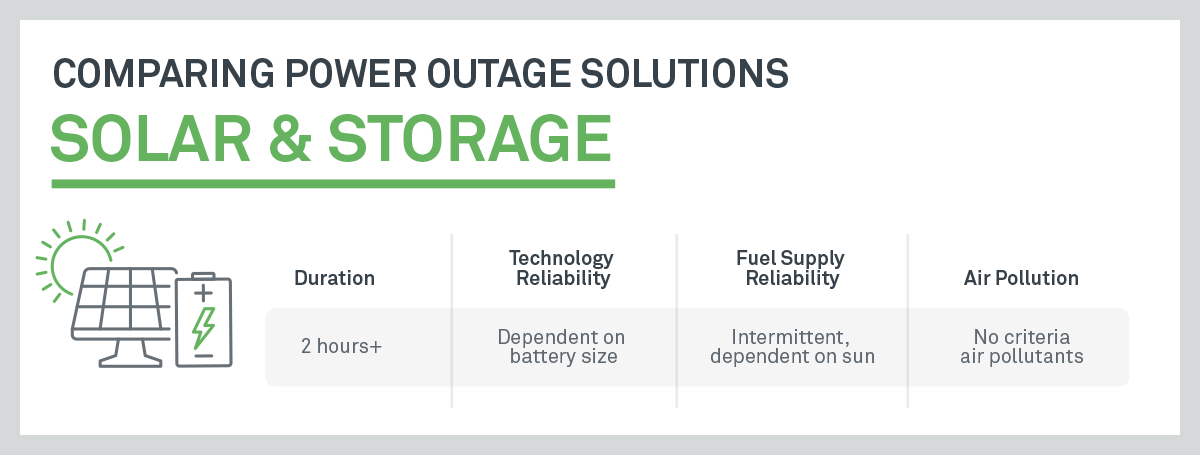
Fuel Cells
Pros:
- Convert fuel into electricity through an electrochemical process rather than combustion
- Avoid emitting harmful criteria air pollutants that cause severe respiratory diseases and poor air quality worldwide
- Cleaner than conventional combustion-based technology (including diesel generators and CHP systems)
- Extremely high efficiency
- Use less fuel than the conventional grid to create same amount of electricity
- Offer fuel flexibility
- Can run on natural gas and reduce carbon dioxide emissions compared to the grid and other combustion technologies
- Can run on biogas or hydrogen (carbon neutral emission options)
- Easily integrated into communities or corporate environments due to compact physical footprint
- Extremely space-efficient with a high power density and minimal noise profile
- Rely on redundant, secure underground natural gas pipeline infrastructure for fuel supply
- Provide power both when the grid is available and when it is down, in perpetuity
- Offers highest level of reliability for critical facilities that rely on an uninterruptible power supply
- Modular by design, so there are multiple independent power generation modules available
- Maintenance doesn’t require a full system shut down, like CHP systems do
- Reductions in utility costs are typically much higher than other systems because of modular design that enables 24×7 power generation with high availability
Cons:
- Generally have a higher up-front cost than CHP and solar plus storage systems because of higher availability and resiliency value
- Upfront cost can be significant for customers unable or unwilling to take advantage of a variety of available financing options
- Businesses or communities that do not value resilient, always-on power, can expect longer payback periods on such investments
- May not be an ideal fit for facilities with large fluctuations in energy use that do not have equipment or processes that lead to some consistent level of load every day, year-round
Takeaway: Fuel cells are the energy solution for you if you’re looking for an “all of the above” technology, so you don’t have to choose between sustainability, resiliency, and cost-effectiveness. They might not be right for you if you want a quick fix solution to short outages and don’t have the ability to invest in a long-term solution.
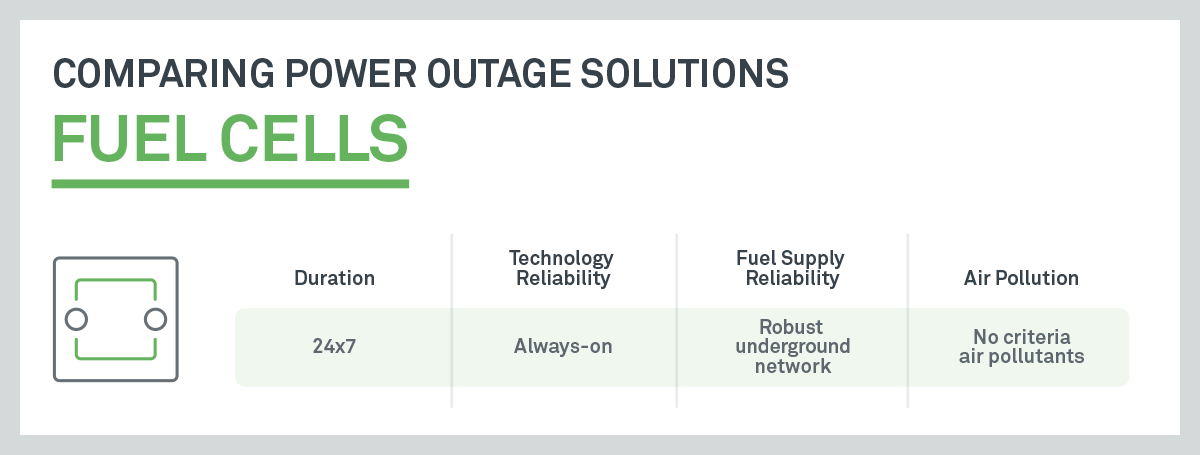
Using fuel cells as building blocks for microgrids
On the basis of outage protection, it all comes down to reliability. The technology that operates 24×7 and provides always-on, uninterruptible power will be the ultimate outage protector. Of all the alternative energy solutions, that’s fuel cells.
The exciting thing about fuel cells is that they’re ideal building blocks for microgrids. Microgrids are localized grids that can pair multiple distributed generation technologies at a single site and operate independently from the traditional power grid in the event of an outage.
Learn more about fuel cell-powered microgrids and how to protect your facility from power outages.

